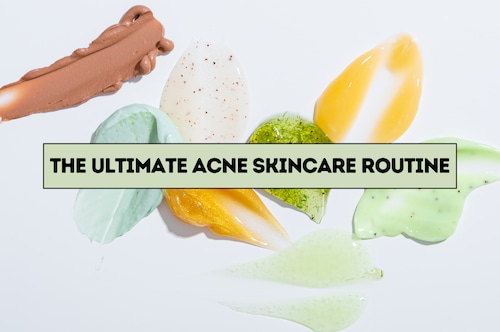Finding a solid skincare routine can be tough, especially if you suffer from acne, as many people do.
That being said, whether it’s hormonal or cystic, keeping a consistent skincare routine is important to help
heal your skin
and
combat acne breakouts
. But with so much information available, where should you start?
To get the low down on all things acne, we spoke with
Dr. Shereen Teymour
, DO
, a board-certified dermatologist specializing in cosmetic and surgical dermatology at
Day Dermatology and Aesthetics
in New York City, and
Dr. Sandy Skotnicki,
MD
, founder of Toronto’s
Bay Dermatology Centre
and co-host of the
Skin to It podcast
.
We got their professional takes on everything from
acne-safe skincare
and ingredient highlights to when you should see a doctor and why viral skincare isn’t right for everyone.
“Social media can be fun, but skincare isn’t one-size-fits-all. What works for an influencer may not be right for your skin. Focus on your skin type, your concerns and stick to evidence-based ingredients,” Dr. Teymour explained. “If a trend sounds too good to be true, it usually is. When in doubt, always talk to your dermatologist instead of TikTok.”
With their help, we combined our favorite skincare products with expert advice and recommendations to create
an effective, acne-fighting skincare routine we think you (and your skin) will love.
The essentials
-
Best acne makeup remover
:Beauty of Joseon Radiance Cleansing Balm
-
Best acne-preventing cleanser
:Aveeno Calm and Restore Nourishing Oat Cleanser
-
Best acne toner
:Paula’s Choice SKIN BALANCING Pore-Reducing Face Tone
-
Best acne-safe serum
:TruSkin Vitamin C Serum
-
Best acne treatment
:Solawave 3 Minute Blue + Red Light Acne Treatment
-
Best acne-safe moisturize
r:Vanicream’s Daily Facial Moisturizer
-
Best acne-safe sunscreen
:e.l.f Cosmetics Holy Hydration! Face Cream SPF 30
or
EltaMD UV Clear Face Sunscreen SPF 46
-
Best acne spot patches
:Patch RX Pimple Patches
What causes acne?
Most of us will have dealt with
acne
at some point in our lifetime. Acne is what happens when excess oil, dead skin cells and bacteria become trapped in our hair follicles.
While hormones, stress, diet and environmental factors can trigger it, genetics and age also make an impact. And while thought to be most common in teenagers, acne is something many of us still deal with even as we get older.
However, with a proper skincare routine, it’s possible to prevent acne and help heal acne scarring.
What ingredients should you look out for?
When it comes to skincare, everyone needs something different, depending on whether your skin is
oily
,
dry
, or a
combination skin type
.
Some ingredients to keep in mind? “When managing acne, ingredients like
benzoyl peroxide
,
salicylic acid
and
retinoids
(like
adapalene
) are tried-and-true,” says Dr. Teymour. “
Azelaic acid
is another favorite that targets acne, redness, and even pigmentation.”
One major piece of advice Dr. Skotnicki shared was that when you do find the ingredients you want to incorporate, be selective with your skincare to avoid overwhelming it. “It’s important to remember that more isn’t always better,” she says. “Look for one or two active ingredients and give them time to work.”
It’s also important not to expect an overnight transformation, as most topical actives used to treat acne take a while to become effective. “It takes 6-8 weeks of consistent use of a product to assess whether it is helping prevent breakouts. Unfortunately, there’s no quick fix!” says Dr. Teymour.
As for one ingredient most acne sufferers can stand to avoid? That would be fragrance.
“While some can tolerate fragrant products with no issues, those with sensitive or reactive skin should avoid both natural and synthetic fragrances,” shares Dr. Skotnicki. “Fragrance is one of the most common causes of allergic contact dermatitis, and because it’s volatile (which is why we smell it), it can trigger headaches, irritation, or sensitivities
,
especially in enclosed environments.”
When to see a dermatologist
A dermatologist is the perfect person to help manage your acne. So, when is going it alone not enough?
“If your acne is painful, scarring, not responding to over-the-counter products after 6–8 weeks or affecting your self-esteem, it’s time to see a board-certified dermatologist,” shares Dr. Teymour.
Dr. Skotnicki echoed that sentiment, sharing, “If you’ve simplified your routine — using fragrance-free, minimal products specifically for irritated or inflamed skin — and still aren’t seeing improvement, it’s time. You may need topical medical treatments for conditions like eczema, rosacea, acne, or dermatitis.”
As for when to schedule an appointment, according to Dr. Teymour, it’s better to do so earlier in your acne journey. “Early intervention can prevent long-term skin changes and help you avoid wasting time and money on ineffective treatments.”
Step 1. Wash your face
If you do anything for your skin, it better be washing your face with a good face wash, specifically one that is fragrance-free.
Both dermatologists emphasized the importance of using a gentle, fragrance-free cleanser that helps clear the skin, such as the
Aveeno Calm and Restore Nourishing Oat Cleanser.
This
is a cleanser Nicole has been using for months, and will continue to repurchase due to how well it has combated her hormonal acne.
Step 2. Tone
Toner is a step we love to use and find essential in our everyday skincare routine.
The purpose of toner is to balance your skin’s pH while also removing impurities and anything else that was not removed while cleansing.
Toner also helps tighten pores, something those suffering from acne often look for in products.
The one we reach for often is the
Colleen Rothschild Matcha Tea Treatment Toner
.
Nicole has been using this toner for two years and has truly seen a difference in her complexion.
Step 3: Milky Toner
While not a necessity in your skincare routine, the
Rhode Glazing Milk
is something we consistently reach for every morning and night for an extra dose of hydration.
In addition to all-day moisture, it also prepares the skin to absorb the rest of the products that are coming up in your routine.
Step 4: Serum
Niacinamide is an ingredient Dr. Skotnicki always likes to stick to, and this
Merit Great Skin Instant Glow Serum
has it and then some.
This serum will give your skin that extra, brightening look without clogging up any of your pores.
Step 5: SPF Moisturizer
If you take anything from this skincare routine, it’s to make sure you are using a proper amount of SPF each and everyday.
“Sunscreen is also a non-negotiable. UV exposure can worsen and prolong those spots,” Dr. Teymour explained to us.
This
e.l.f moisturizer
not only contains 30 SPF but also peptides and other acne-fighting ingredients that’ll help combat stubborn acne, all while keeping your skin hydrated.
Step 6: Eye Cream
This can be a step in your routine that is often forgotten but is also incredibly important.
While our whole faces need vitamin C and peptides, why shouldn’t our eyes get a bit of extra attention from products like that as well?
This
iNNBEAUTY Project under-eye cream
will give your under eyes that perfect, wide-awake look we usually need in the morning.
Step 1. Remove any makeup
Ask everyone from a dermatologist to your best friend, and they’ll tell you never to sleep in your makeup. Doing this can clog your pores even more.
To properly cleanse and remove sunscreen and daytime skincare, you can incorporate a cleansing balm, like
Pond’s Cold Cream
, or a micellar water before washing your face.
When it comes to a fragrance-free cleanser, Dr. Skotnicki’s “daily go-to” is
Bioderma’s Micellar Water
.
So, remove any traces of foundation and sunscreen before bed to give your skin a fresh start come morning. It’s an extra step, but it ensures your skin enters its rest and repair state at its best.
Step 2: Face Wash
Hydration is key when it comes to cleansing at the end of the day.
Some topical acne creams can dry your skin out, which we all vividly remember from our teenage years.
This is why it’s so important to find a face wash that nourishes and cleanses without stripping your skin.
A lightweight foaming cleanser, like
Sulwhasoo’s Gentle Cleansing Foam
, removes everyday buildup without causing excessive dryness.
Step 3: Face Mask
Dr. Skotnicki says, “It’s about intentional, minimal, evidence-based skincare — not chasing trends.”
When you’re looking into ingredients, choose something that you understand and ingredients that work for you.
For example, we want our face mask to help clear out our pores, which is why we reach for the
Beauty of Joseon Ground Rice and Honey Glow Mask
.
Known for being anti-bacterial, the sensitive skin-friendly mask provides ample nourishment thanks to the honey. It also features a type of facial clay known as kaolin, which helps absorb oil.
Step 4: Toner
It’s nice to have a one-and-done toner pad that offers just the right amount for nightly use.
Medicube’s viral Zero Pore Pads 2.0
do just that by exfoliating without irritating already-sensitive skin.
Packed with lactic acid and salicylic acid, these powerful pads don’t dry your skin out, but still provide daily exfoliation.
If you feel that your skin is irritated easily, start with weekly use.
Step 5: Serums
Serums are concentrated, often active products that should be considered an addition to your basic skincare routine.
Known for delivering lightweight nourishment, most serums work to benefit your skin.
What’s nice about serums is that they are typically targeted in one or a few different ways.
For example, we use the
Colleen Rothschild Overnight Treatment
.
As the name suggests, it’s an overnight serum and uses azelaic acid, witch hazel and more to treat blemish-prone skin.
Dr. Shereen Teymour says, “
Azelaic acid
is another favorite that targets acne, redness, and even pigmentation.”
Step 6: Moisturizer
You don’t always need to spend big bucks to get a nice product.
Some luxury options are great and a treat to buy, but there are drugstore options that work just as well.
Take
Vanicream’s Daily Facial Moisturizer
, for example. Clocking in at under $15, the noncomedogenic moisturizer works nicely on sensitive skin types and helps soothe irritation often caused by acne.
It also has ceremides and hyaluronic acid for added hydration.
Step 7: Acne Treatments
Keep active pimples covered with a hydrocollide patch during the day, as it helps prevent dirt and environmental factors from irritating the spot.
Options, such as
Patch RX Pimple Patches
, come with 100+ covers that work to treat and heal any active blemishes.
It works similarly to wound care, creating a barrier over the area.
By absorbing the gunk inside and leaving behind a flattened surface, these small but powerful pimple patches work wonders.
Summary
At the end of the day, it’s all about finding what works for you, and for that, it typically doesn’t take much.
“For healthy skin, you don’t need a dozen steps,” says Dr. Skotnicki. “Much of the beauty industry blurs the line between self-care and skincare. True skincare is simple.”
She notes that the most basic of routines can be simplified down to the following: A fragrance-free cleanser, a mineral sunscreen and a moisturizer with a few targeted actives, depending on age and concerns.
So if you’re starting your acne-fighting journey, remember to be gentle, focus on healing and don’t be afraid to reach out to a dermatologist (or two) to make your blemishes a thing of the past.
All of your beauty needs & more
-
Megan Moroney just revealed her lip combo, and you can shop it all at Sephora right now
-
Dua Lipa used this unexpected luxury makeup combo during her latest concert
-
This store has Sol de Janeiro’s new limited edition glow body oil early. Here’s where to find it
-
Billie Eilish added 23 new shows to the ‘Hit Me Hard and Soft’ tour, here’s how to get presale tickets
Our journalism needs your support. Please subscribe today to
NJ.com
.
Amanda Edelman can be reached at
. Have a tip? Tell us at
nj.com/tips
.
Nicole Iuzzolino can be reached at
. Have a tip? Tell us at
nj.com/tips
.






